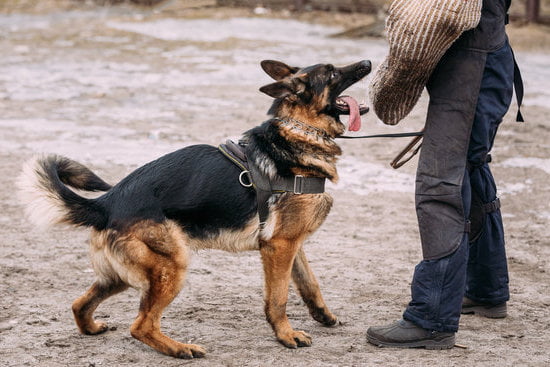Are you wondering how to train a therapy dog for people with depression? Therapy dogs play an important role in helping individuals with mental health issues, including depression. These specially trained dogs provide emotional support and comfort to those who are struggling with their mental well-being. In this article, we will explore the various aspects of training a therapy dog to work specifically with individuals experiencing depression, from choosing the right dog to handling emotional support situations.
Therapy dogs have proven to be beneficial for individuals with depression, offering comfort, companionship, and a sense of purpose. These dogs can make a significant impact on the lives of those dealing with mental health challenges. Understanding the essential role that therapy dogs play in mental health is crucial as we delve into the specific training techniques for working with individuals experiencing depression.
In this comprehensive guide, we will discuss the benefits of therapy dogs for people with depression and provide valuable insights into choosing the right dog for therapy work. We will also cover basic obedience training, advanced training techniques, socialization and desensitization training, as well as how to handle emotional support situations as a therapy dog handler.
This article aims to provide a thorough understanding of the role and impact of therapy dogs on individuals struggling with depression and offer practical guidance on how to get started in training a therapy dog for this purpose.
The Benefits of Therapy Dogs for People With Depression
Therapy dogs can play a crucial role in providing comfort, support, and companionship to individuals struggling with depression. According to studies, interaction with therapy dogs can help reduce symptoms of depression and anxiety by lowering levels of cortisol, the stress hormone, and increasing the production of oxytocin, the “feel-good” hormone.
This can result in a boost in mood and an overall improvement in mental well-being. Additionally, therapy dogs provide non-judgmental companionship and a sense of purpose to individuals who may feel isolated or lonely due to their depression.
Studies have also shown that owning a dog can lead to increased physical activity and social interaction, both of which can be beneficial for individuals with depression. Taking a therapy dog for walks or engaging in playtime activities can promote exercise and outdoor exposure, which are known to have positive effects on mental health.
Furthermore, the presence of a therapy dog can act as a conversation starter and icebreaker, helping individuals with depression connect with others and reduce feelings of loneliness.
When considering the benefits of therapy dogs for people with depression, it is important to recognize that these animals offer emotional support that goes beyond what traditional treatment methods can provide. They offer unconditional love, understanding, and empathy without any expectations or conditions. The bond between a therapy dog and its owner has the potential to alleviate feelings of sadness, hopelessness, and despair commonly associated with depression.
| Benefits | Impact |
|---|---|
| Reduction in symptoms of depression and anxiety | Lowering levels of cortisol and increasing production of oxytocin |
| Increased physical activity and social interaction | Promoting exercise and outdoor exposure |
| Unconditional love, understanding, and empathy | Alleviating feelings of sadness, hopelessness, and despair |
Choosing the Right Dog for Therapy Work
When it comes to choosing the right dog for therapy work, there are several important factors to consider. Therapy dogs come in all shapes and sizes, but not every dog is cut out for the demands of being a therapy dog for individuals with depression. It’s crucial to select a dog that has the right temperament, personality, and training potential to excel in this role.
Temperament and Personality
The first thing to consider when choosing a dog for therapy work is their temperament and personality. Dogs that will be working with individuals struggling with depression need to be calm, patient, and gentle. They should also be friendly and sociable, as they will often be interacting with unfamiliar people in various settings. Additionally, the dog should be comfortable in new environments and able to remain focused around distractions.
Breed Selection
While any breed can potentially become a therapy dog, certain breeds are more commonly seen in this role due to their inherent traits. Breeds like Labrador Retrievers, Golden Retrievers, Poodles, and mixed breed dogs often make excellent therapy dogs due to their friendly nature and intelligence. However, individual temperament is more important than breed when it comes to selecting the right therapy dog for people with depression.
Assessment and Training Potential
Before selecting a potential therapy dog candidate, it’s important to assess their natural abilities and training potential. Look for dogs that are eager to please, quick learners, and responsive to training cues. If possible, work with a professional trainer or behaviorist who has experience training therapy dogs for individuals with depression to ensure you’re selecting a suitable candidate.
When considering how to train a therapy dog for people with depression it is important to understand that choosing the right dog is an essential first step in setting them up for success in this critical role. Investing time upfront in finding the right candidate will ultimately make the training process smoother and increase the likelihood of the dog making a positive impact on those struggling with mental health challenges such as depression.
Basic Obedience Training for Therapy Dogs
Basic obedience training is an essential foundation for any therapy dog, especially those who will be working with individuals dealing with depression. It is important for these dogs to be well-behaved, obedient, and responsive to commands in various environments. This type of training will not only allow the dog to better fulfill their role but also ensure the safety and comfort of the people they are helping.
The first step in basic obedience training is teaching the dog simple commands such as sit, stay, come, and heel. These commands will form the basis of the dog’s behavior in public and private settings. Positive reinforcement techniques are often used to encourage desired behaviors and discourage unwanted ones. Consistency in training is key, as it helps the dog understand what is expected of them.
Furthermore, therapy dogs must be comfortable walking on a leash without pulling or wandering off. They should also be trained to remain calm around distractions like other animals or loud noises. This is crucial when they are providing support to individuals with depression who may already be feeling anxious or overwhelmed. Proper socialization and desensitization techniques should be employed during this phase of training to ensure the dog remains calm and focused in any situation.
| Therapy Dog Training | Data |
|---|---|
| Command Training | Dogs must learn simple commands like sit, stay, come, and heel through positive reinforcement techniques. |
| Leash Training | Therapy dogs need to walk calmly on a leash without pulling or getting distracted by their surroundings. |
| Socialization & Desensitization | Dogs should be exposed to various situations while trained to remain calm and focused around distractions. |
Advanced Training Techniques for Therapy Dogs
Building on Basic Skills
Once your therapy dog has mastered basic obedience training, it’s time to move on to more advanced techniques. This includes training your dog to respond to a wider range of commands and cues, as well as refining their behavior in various situations. Advanced training will help your therapy dog be better prepared to handle the challenges that may arise when working with individuals who have depression.
Emotional Support Training
One important aspect of training a therapy dog for people with depression is teaching them how to provide emotional support. This can include techniques such as learning how to initiate physical contact in a gentle and comforting manner, understanding when to offer emotional support, and recognizing signs of distress in the person they are assisting. Using positive reinforcement, you can train your dog to instinctively offer comfort and reassurance when needed.
Handling Challenging Environments
Therapy dogs often need to work in a variety of environments, including hospitals, nursing homes, and public spaces. It’s crucial to train your therapy dog how to remain calm and focused in busy or chaotic settings.
This can involve exposure to different sounds, sights, and smells, as well as desensitization training to help them stay relaxed under various circumstances. By gradually exposing your therapy dog to different environments, you can help them become more adaptable and capable of providing support to individuals with depression in any situation.
By incorporating these advanced training techniques into your therapy dog’s regimen, you can ensure that they are well-equipped to provide valuable emotional support for individuals struggling with depression.
Socialization and Desensitization Training for Therapy Dogs
Socialization and desensitization training are crucial for therapy dogs, especially those who will be working with individuals who have depression. Here are some important steps to take when training a therapy dog for people with depression:
- Expose the dog to various environments and situations: It’s essential to expose the therapy dog to different environments, people, and experiences. This will help them become comfortable and calm in various settings, which is important when working with individuals who may be struggling with depression.
- Teach the dog to remain calm in stressful situations: Therapy dogs need to remain calm and composed even in stressful or overwhelming situations. Through desensitization training, you can gradually expose the dog to increasingly challenging scenarios while teaching them how to remain relaxed and focused.
- Practice positive interactions with different types of people: Individuals struggling with depression may come from diverse backgrounds and have varying levels of emotional needs. It’s important to train therapy dogs on how to interact positively with different types of people, including those who may be experiencing heightened emotions.
Training a therapy dog for people with depression requires patience, consistency, and specialized techniques that address the unique needs of individuals dealing with mental health challenges. By focusing on socialization and desensitization training, therapy dogs can provide invaluable support and comfort to those in need.
Remember that every therapy dog is unique, so it’s important to tailor training methods based on the specific temperament and abilities of each individual dog. With dedication and proper training, therapy dogs can make a significant impact on the well-being of individuals struggling with depression.
Handling Emotional Support Situations With a Therapy Dog
As therapy dogs are specifically trained to provide comfort and support to individuals with mental health issues such as depression, it is crucial for handlers to understand how to effectively handle emotional support situations with their therapy dog. Here are some important considerations for ensuring that your therapy dog can effectively provide emotional support:
- Empathy and Sensitivity: A therapy dog handler must be empathetic and sensitive to the needs of the individual seeking emotional support. It is important to understand the cues and body language of the person in order to gauge the appropriate response from the therapy dog.
- Creating a Calm Environment: In emotional support situations, it is essential for the handler to create a calm and safe environment for both the individual and the therapy dog. This may involve finding a quiet space free from distractions in which both can comfortably interact.
- Encouraging Interaction: The handler should encourage positive interaction between the individual and the therapy dog. This could involve allowing the individual to pet or hold the dog, or engaging in activities such as playing with a toy together.
For individuals with depression, having a therapy dog present during emotional support situations can significantly improve their mood and provide them with a sense of comfort and companionship. Knowing how to navigate these situations with empathy and understanding is crucial in maximizing the benefits that a therapy dog can provide.
Ultimately, by properly handling emotional support situations with a therapy dog, handlers can help individuals with depression experience improved mental well-being through meaningful interactions with their furry companion. Understanding these principles is essential for anyone looking to train a therapy dog for people with depression.
Maintaining the Well-Being of a Therapy Dog
As a therapy dog, it is essential to prioritize the well-being and welfare of your furry companion. Just as you would focus on the mental and emotional health of individuals with depression, it is equally important to ensure that your therapy dog is well cared for and in good physical, mental, and emotional condition.
One key aspect of maintaining the well-being of a therapy dog is ensuring their physical health. Regular visits to the veterinarian for check-ups, vaccinations, and preventive care are crucial. Additionally, proper nutrition, exercise, and grooming are essential for keeping your therapy dog healthy and happy. It is important to provide a safe and comfortable living environment for your therapy dog as well.
Another aspect to consider is the mental and emotional well-being of your therapy dog. Ensuring that they receive adequate socialization with other dogs and people is important for their overall happiness. Engaging in activities that stimulate their mind, such as puzzle games or training exercises, can also contribute to their mental well-being.
Furthermore, as a handler of a therapy dog for people with depression, it is important to be attuned to your dog’s behavior and emotional state. Dogs can often absorb the emotions of those around them, so it’s crucial to practice self-care as a handler in order to prevent any negative impact on your therapy dog’s well-being.
Overall, maintaining the well-being of a therapy dog involves a holistic approach that encompasses physical health, mental stimulation, socialization, and emotional awareness. By prioritizing the welfare of your therapy dog, you can ensure that they are able to fulfill their role in providing comfort and support to individuals with depression.
It’s essential to remember that becoming a handler for a therapy dog comes with its own responsibility towards making sure both you and your four-pawed friend maintain enough balance within yourselves before working with others on sensitive topics such as depression or anxiety.
In order to know how best train yourself AND subsequently train your buddy properly before working together as an official team you probably want at least some kind contact training sessions what’s meant include contacts between dogs/handlers already experienced enough assist taking care someone else who needs supportive comfort situated somewhere outside public space environments-thee.g.
assisted-living facility where recipients should feel secure not burdened by crowds strangers whenever possible given potential decrease risk accidents alike by having others share personal spaces theirselves accordingly.
Conclusion
In conclusion, therapy dogs play a crucial role in providing support and comfort to individuals with depression. The presence of a well-trained therapy dog can significantly improve the mental well-being of those struggling with this condition. From providing companionship and reducing feelings of loneliness to encouraging physical activity and reducing stress, the benefits of therapy dogs for people with depression are undeniable.
For those interested in training a therapy dog for people with depression, it’s important to consider the specific needs and challenges faced by individuals dealing with this condition. Choosing the right dog breed, implementing basic obedience training, and utilizing advanced techniques can all contribute to creating a successful therapy dog that is well-equipped to handle emotional support situations.
Socialization and desensitization training are also crucial aspects that should be carefully considered when preparing a therapy dog to work with individuals experiencing depression.
Getting started on training a therapy dog for people with depression requires dedication, patience, and a genuine desire to make a positive impact on the lives of others. By following the steps outlined in this article and seeking guidance from professional trainers or organizations specializing in therapy dog work, individuals can take meaningful steps towards providing valuable support to those in need.
Ultimately, training a therapy dog for people with depression involves not only enhancing the well-being of the individual but also contributing to the broader effort to promote mental health awareness and compassion within our communities.
Frequently Asked Questions
Can a Therapy Dog Help With Depression?
A therapy dog can indeed help with depression by providing companionship, reducing feelings of loneliness, and increasing physical activity through walks and play. The presence of a therapy dog can also release feel-good hormones in the human brain.
How Do You Train an Emotional Support Dog for Depression?
Training an emotional support dog for depression involves teaching basic obedience commands, socialization with other people and animals, and desensitization to stressful situations. It’s important to work with a professional trainer to ensure the dog is well-prepared for its role.
How Do I Make My Dog a Psychiatric Service Animal?
To make your dog a psychiatric service animal, you would need to first qualify for a psychiatric service animal based on your disability. Then, the dog would need to undergo specialized training that focuses on tasks specific to mitigating your psychiatric disability under the guidance of a professional trainer or organization.

Welcome to the blog! I am a professional dog trainer and have been working with dogs for many years. In this blog, I will be discussing various topics related to dog training, including tips, tricks, and advice. I hope you find this information helpful and informative. Thanks for reading!





